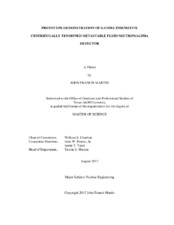| dc.description.abstract | Tensioned metastable fluid detectors are a novel detector concept with a wide array of potential uses. A particularly interesting application is as a real-time alpha and neutron detector that is also insensitive to gamma rays. This type of detector could have many uses for safeguards and nonproliferation including reprocessing facilities and border protection. For safeguards facilities, the detector could be used to perform online measurements of alpha-emitting nuclides such as uranium and plutonium in the reprocessing fluids. The online measurements could include dissolver tank fluids and products solution fluids where conventional detector use is infeasible.
In this research, an initial characterization of one version of the tensioned metastable fluid detector (TMFD) was performed. A TMFD works by putting a fluid under negative pressure or tension. Once under tension, small amounts of energy can cause the tensioned molecules in the fluid to burst apart forming a visible bubble. The small amount of energy can come from nuclear particles such as alphas and neutrons. Another key concept of the TMFD is that the amount of energy needed to form a bubble is dependent on the negative pressure of the fluid. By varying the negative pressure, only particles of a desired energy or higher would form bubbles in the system allowing for a form of spectroscopy. The spectroscopy could be used, along with a volume measurement, to quantify the amount of uranium or plutonium in the reprocessing fluid.
The initial characterization was performed using gamma, neutron, and alpha radiation. The gamma-ray tests were performed using an external 137Cs source next to the system. Several neutron tests were performed using an external 252Cf sourceincluding a test to verify compliance with the inverse square law and a test varying the pressure of the TMFD to test spectroscopy uses. Last, alpha-radiation tests were conducted using various amounts of depleted uranium dissolved in the working fluid of the detector. This study confirmed that the detector system is insensitive to low amounts of gamma-rays. It also confirmed that by varying the negative pressure in the detector, different energy neutrons could be detected. Last, the study confirmed that the detector could be used to detect alpha particles in real time but that additional work was needed on the design to ensure reliable results.
The TMFD can be used to detect alpha particles and neutrons and is insensitive to gamma-rays. However, the current design of the system is a prototype and must be redesigned in order to be used in a reprocessing facility. Also, a lower negative pressure is needed for neutron detection compared to alpha detection. The pressure discrepancy would cause the detector to be unable to detect alpha particles in a large neutron radiation field making the detector unusable at the dissolver tank, but still usable for the reprocessing product lines. | en |


